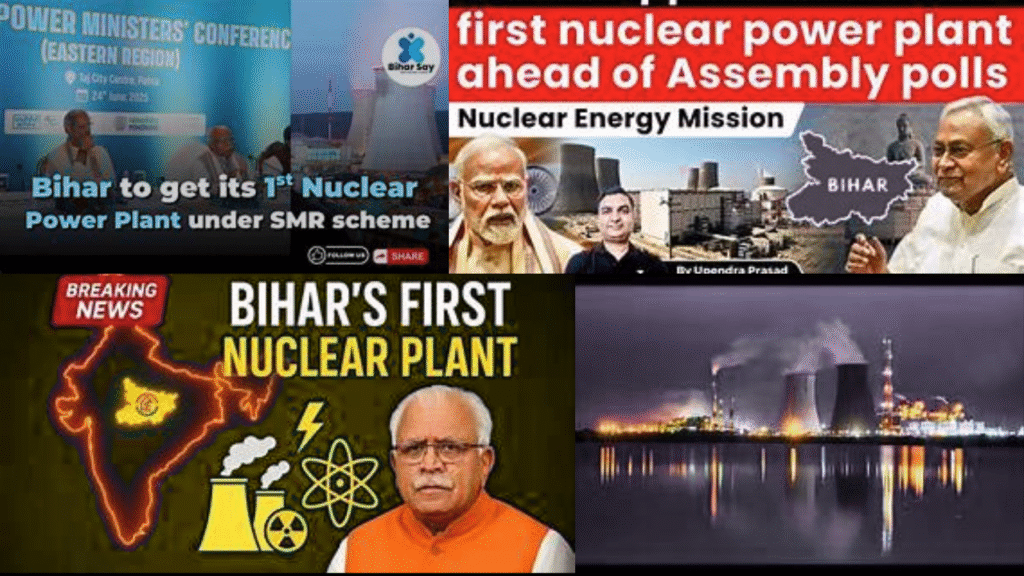The First Nuclear Power Plant in Bihar

India’s New Nuclear Energy Mission Will Provide Bihar With Its First Nuclear Power Plant.
Important Points to Remember:
Concerning the The First Nuclear Power Plant
Notification and Acceptance:
The Union Power Minister declared during the 5th Eastern Zonal Conference of Power Ministers in Patna that the Center had approved the establishment of a nuclear power plant in Bihar that will use Small Modular Reactor (SMR) technology.
The summit, which was attended by representatives from Bihar, West Bengal, Odisha, Jharkhand, and the Andaman & Nicobar Islands, was an important step in the advancement of nuclear energy in eastern India.
The First Nuclear Why Use Nuclear Power?
Compared to coal-based plants, nuclear energy is thought to be a reliable and environmentally benign option. Nuclear power can assist guarantee steady electricity without endangering the environment in light of growing power demands, particularly in rapidly developing areas like Bihar.
The First Nuclear Power Plant in Bihar Place and Arrangement
Discussions between the Central and State governments are still under progress, but the precise location has not yet been decided. Safety, accessibility, and the availability of infrastructure will all be considered while choosing the location.
Benefits for Bihar Better Power Supply: The plant will greatly increase the state’s access to power.
- It will draw businesses and generate jobs in the area. Green Energy Transition: Reliance on fossil fuels will be lessened with nuclear power.
- Around the project, new technical institutes and training facilities may open.
Acknowledgment and Acceptance:
The First Nuclear Power Plant in Bihar At the 5th Eastern Zonal Conference of Power Ministers in Patna, the Union Power Minister announced that the Center had given its approval for the construction of a nuclear power plant in Bihar that will employ Small Modular Reactor (SMR) technology.
Representatives from Bihar, West Bengal, Odisha, Jharkhand, and the Andaman & Nicobar Islands attended the summit, which marked a significant milestone in the development of nuclear energy in eastern India.
The First Nuclear Impact on the Nation
This action is in line with India’s goal to raise the proportion of nuclear and other non-fossil fuel energy sources in the country’s power mix. It makes India even more determined to reach net-zero carbon emissions by 2070.
Relevance for Bihar:
The First Nuclear Power Plant in Bihar It is anticipated that the project will guarantee a steady supply of electricity, draw in industrial investment, generate job opportunities, and enhance technology in the state.
This project is viewed as a revolutionary shift in Bihar’s energy landscape, considering the region’s long-standing problems with power outages and inadequate infrastructure
Emphasis on Native Technology
With a ₹20,000 crore budget, the mission places a high priority on developing indigenous technology, particularly Small Modular Reactors (SMRs).
By 2033, at least five domestically designed SMRs are to be developed and put into service, utilizing India’s proficiency with Pressurized Heavy Water Reactors (PHWRs).
To improve national energy security, plans are also underway to establish nuclear power plants in each state.
Private Sector Involvement:
Legislative amendments to the Civil Liability for Nuclear Damage Act of 2010 and the Atomic Energy Act of 1962 are being proposed in order to promote private sector participation.
With NPCIL managing reactor operations and private organizations contributing land, funds, and capital, these improvements would speed up the construction of nuclear projects and economic growth.
SMRs, or small modular reactors, are what?
Advanced nuclear reactors known as SMRs have a maximum capacity of 300 MW(e), which is around one-third that of conventional reactors.
They provide an affordable, cutting-edge, and safer nuclear technology that is perfect for areas with modest power needs or where large-scale facilities are impractical.
In order to address the energy needs of rural locations and repurpose coal-based power facilities, the Bhabha Atomic Research Centre (BARC) is developing SMRs.
In order to generate hydrogen and make use of India’s plentiful thorium deposits, the Department of Atomic Energy (DAE) is also building high-temperature gas-cooled and molten salt reactors.
Additional Current Events in the Power Industry
Projects Using Batteries to Store Energy:
The First Nuclear Power Plant in Bihar The Central Government has authorized a 1,000 MW battery storage project in Bihar in addition to the nuclear reactor.
This would improve grid stability and facilitate the incorporation of renewable energy, with a viability gap investment of ₹18 lakh per MW.
On June 20, 2025, the prime minister set the cornerstone for a 500 MW Battery Energy Storage System (BESS) project in Siwan.
Extra Assistance for Bihar:
The Center has committed to provide Bihar with an extra 500 MW of electricity over the next three to six months in order to fulfill the summer’s peak power demand.
The state has also been commended for making great strides in lowering technical and commercial losses and deploying 8 million smart met
In conclusion
The First Nuclear Power Plant in Bihar More than just a power project, Bihar’s first nuclear power plant is an indication of the state’s expanding position in India’s energy destiny. This program promises to provide clean energy, economic opportunity, and a better future for Bihar and its people as the plans come to fruition.

Pingback: Raja Singh Leaves BJP-2025 Disputed The revolt
That’s great